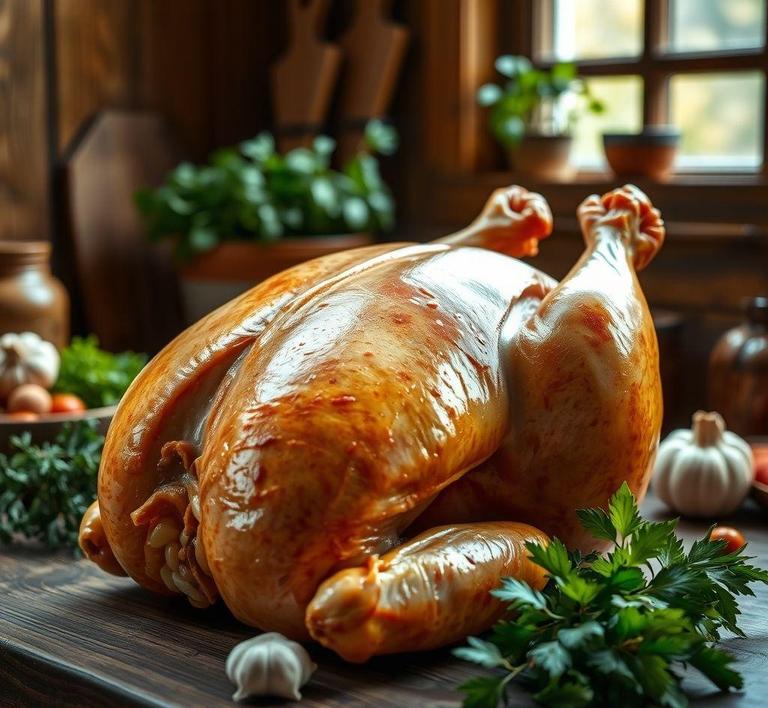Refreezing fresh chicken is something many people wonder about, especially when they’re unsure if they can safely store chicken for a longer period. While it’s generally safe to refreeze chicken if it’s been thawed in the fridge, there are a few important guidelines to follow. You’ll want to make sure that the chicken hasn’t been left out at room temperature for too long and that it hasn’t been refrozen multiple times. In this guide, we’ll walk you through the best practices for refreezing fresh chicken to ensure it remains safe and delicious when you’re ready to cook it.
Can You Refreeze Fresh Chicken?

The short answer: Yes, you can refreeze fresh chicken, but with important caveats.
When we say "fresh chicken," we generally mean chicken that has been thawed from a frozen state or chicken that was never frozen but has been stored chilled (in the fridge). If you’ve thawed chicken from the freezer but haven’t cooked it, you might be tempted to refreeze it to avoid waste. The USDA states that chicken that has been thawed in the refrigerator can be safely refrozen without cooking, as long as it has stayed at refrigerator temperature (below 40°F or 4°C) and has not been left out at room temperature for extended periods.
However, if the chicken was thawed by other methods-such as in warm water or in the microwave-or has been sitting out too long, refreezing it is risky and not recommended. The reason is that bacteria multiply quickly at temperatures above 40°F, and refreezing won’t kill those bacteria; it simply pauses their growth. When thawed again, the bacterial load could be dangerously high, increasing the risk of foodborne illness.
If the chicken was never frozen before, meaning it’s truly fresh and just purchased from the store, you can freeze it safely as long as it hasn’t been out of the fridge for more than two days (or one day if it’s above 40°F). But if it’s fresh and frozen once, thawed in the fridge, and you want to freeze again, this is where the question of quality and safety becomes important, which we’ll explore next.
How To Refreeze Fresh Chicken?
If you decide to refreeze chicken, doing it right can make a significant difference in safety and quality. Here’s a detailed step-by-step guide:
- Keep it cold: Always ensure the chicken has been kept cold – ideally at 40°F (4°C) or below – the entire time it was thawed. If it’s been out for more than two hours at room temperature, discard it instead of refreezing.
- Refreeze promptly: Refreeze chicken as soon as possible after you decide you won’t be cooking it. The longer it stays thawed, even in the fridge, the more chances bacteria have to multiply and the more quality deteriorates.
- Package properly: To avoid freezer burn and preserve quality, rewrap the chicken tightly. Use airtight freezer bags or vacuum-sealed packaging. Remove as much air as possible to prevent ice crystals from forming, which damage texture and flavor.
- Label and date: Always mark the date of refreezing on the package. Chicken should ideally be consumed within 3-6 months of freezing for optimal taste and texture.
- Thaw safely next time: When ready to use, thaw the chicken in the refrigerator (not at room temperature) to minimize bacterial growth.
If you thawed the chicken by quick methods like microwaving or water bath, it’s better to cook it first and then freeze the cooked meat rather than refreezing it raw.
Quality Impact
While refreezing fresh chicken is generally safe if done properly, it almost always comes with a hit to quality.
- Texture degradation: Freezing causes ice crystals to form inside the meat’s muscle fibers. The first freeze creates some ice crystals, which damage the cell structure. When refrozen, these crystals form again, causing further damage. The result is often chicken that feels mushy, dry, or stringy when cooked.
- Flavor loss: The repeated freezing and thawing cycles can cause some loss of the fresh chicken’s natural flavors. You might notice the meat tastes less vibrant or slightly off.
- Moisture loss: Each freeze-thaw cycle forces out water from the meat, which evaporates during cooking. This can make the chicken less juicy and tender.
- Appearance: Chicken refrozen multiple times might develop discoloration or a slightly frosty appearance due to ice crystal formation. While not harmful, it can be visually unappealing.
In practical terms, if you’re refreezing chicken purely for safety reasons and plan to use it in heavily seasoned or sauced dishes (like stews, curries, or casseroles), the quality drop is less noticeable. But if you want to grill or roast it where texture and flavor shine, repeated freezing will be more apparent.
Refreezing fresh chicken is possible and safe under the right conditions-primarily if the chicken was thawed in the refrigerator and never left out at unsafe temperatures. However, the convenience of refreezing comes at a price: the quality of the meat will likely decline with every freeze-thaw cycle, resulting in a drier, less flavorful final product.
To maximize safety and quality:
- Always thaw chicken in the fridge.
- Refreeze promptly and properly package.
- Consider cooking the chicken before freezing if it’s been thawed by rapid methods.
- Aim to use refrozen chicken in dishes where texture and flavor aren’t the star players.
When in doubt, prioritize safety. Food poisoning from improperly handled chicken is no joke. But with mindful handling, refreezing chicken can be a practical way to reduce waste and stretch your grocery budget.
Is It Safe To Refreeze Fresh Chicken?
When it comes to refreezing fresh chicken, the short answer is: sometimes, but with caution. The safety of refreezing largely depends on how the chicken was handled and stored between thawing and the decision to freeze again.
Fresh chicken straight from the store is usually frozen once during processing before reaching you. If you thaw it properly in the refrigerator and keep it chilled at all times, refreezing is generally safe. The USDA notes that chicken thawed in the fridge can be refrozen without cooking, but with a caveat: the quality may suffer due to moisture loss during thawing. The texture might become drier or tougher after refreezing.
However, if chicken has been thawed outside the fridge or left at room temperature for over 2 hours (or 1 hour if above 90°F/32°C), harmful bacteria can multiply rapidly, increasing the risk of foodborne illness. Refreezing under these conditions does not kill bacteria – it only pauses their growth temporarily until thawed again. Therefore, refreezing chicken that has been mishandled can be unsafe.
In short, refreezing fresh chicken is safe only if it has been thawed properly and kept cold throughout. Otherwise, it’s best to cook the chicken before freezing again to ensure safety.
Signs That Fresh Chicken Should Not Be Refrozen
Knowing when chicken is no longer fit for refreezing is critical for food safety. Here are the key warning signs:
-
Off Odor
Fresh chicken should have a mild, almost neutral smell. If it emits a sour, ammonia-like, or rotten odor, it’s a clear sign bacteria have proliferated, making it unsafe to refreeze or eat.
-
Slimy or Sticky Texture
Chicken that feels slimy or sticky to the touch indicates bacterial growth on the surface. This texture change usually happens after chicken is left too long in unsafe conditions.
-
Discoloration
Fresh chicken has a pale pink hue with white fat. Any grayish, greenish, or brown patches are red flags signaling spoilage.
-
Thawed Too Long at Room Temperature
If chicken has been out of refrigeration for more than 2 hours, or 1 hour in warmer environments, it should not be refrozen. Bacteria multiply quickly in the ‘danger zone’ (40°F – 140°F or 4°C – 60°C).
-
Leftover Chicken That Sat Too Long After Cooking
If cooked chicken has been left out for over 2 hours, it’s best to discard or consume immediately rather than refreezing.
If you notice any of these signs, it’s safer to discard the chicken than risk food poisoning.
Common Refreezing Mistakes
Many people unintentionally jeopardize their food safety or the chicken’s quality with these frequent missteps:
-
Refreezing Chicken Thawed at Room Temperature
The biggest mistake is thawing chicken on the countertop or in warm water and then refreezing it. Bacteria thrive at these temperatures and can cause illness even after freezing.
-
Refreezing Without Proper Wrapping
Exposure to air causes freezer burn, drying out the chicken and leading to loss of flavor and texture. Make sure to use airtight, moisture-proof packaging like vacuum seal bags or heavy-duty freezer wrap.
-
Repeated Freeze-Thaw Cycles
Constantly thawing and refreezing chicken degrades quality rapidly, making the meat mushy and unpleasant.
-
Ignoring the Time Limits
Even if chicken was thawed properly, it shouldn’t be refrozen indefinitely. The USDA recommends refreezing within 1-2 days of thawing.
-
Freezing Chicken That’s Already Spoiled
Freezing does not reverse spoilage. Always check freshness before refreezing.
Tips And Tricks
To safely refreeze fresh chicken while preserving the best quality, consider these practical tips:
-
Always Thaw in the Refrigerator
This keeps chicken below 40°F (4°C) and slows bacterial growth.
-
Freeze Quickly After Thawing
Once chicken is fully thawed and you decide not to use it, refreeze within 1-2 days.
-
Use Airtight Packaging
Wrap chicken tightly in plastic wrap, aluminum foil, or vacuum-sealed bags to minimize freezer burn.
-
Label and Date Packages
Keep track of how long chicken has been frozen to avoid keeping it too long.
-
Cook Before Refreezing When in Doubt
If chicken has been thawed too long or at unsafe temperatures, cook it fully before freezing again. Cooking kills bacteria, making refreezing safer.
-
Avoid Overloading the Freezer
Crowding the freezer slows the freezing process, which can impact safety and texture.
Conclusion
Refreezing fresh chicken can be perfectly safe – but only if done thoughtfully. Proper thawing in the fridge, paying close attention to spoilage signs, and avoiding common mistakes are key to preventing foodborne illness and preserving quality. When in doubt, cooking before refreezing is the safest bet. By following these guidelines, you can confidently manage your chicken supplies, reduce food waste, and keep your meals delicious and safe.


